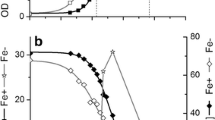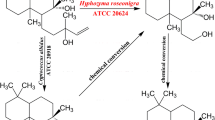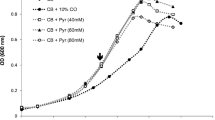Abstract
The intracellular proteomes of the Penicillium chrysogenum throughout pilot and industrial processes were investigated by using 2-DE combined with MALDI-TOF-TOF MS, respectively. We detected a total of 223 spots corresponding to 154 proteins and 231 spots corresponding to 157 proteins throughout pilot and industrial processes, respectively. The levels of glyceraldehyde-3-phosphate dehydrogenase increased (5.1- and 2.5-fold) under the pilot process, while its levels were no significant changes under the industrial process at 140 and 170 h when compared with that at 2 h. The levels of isocitrate lyase and fumarate hydratase were increased significantly under the industrial process, while their levels had no obvious changes after 20 h of fermentation throughout the pilot process. These results indicate that there were remarkable differences in carbohydrate metabolism (including glycolysis, gluconeogenesis, pentose phosphate pathway, and tricarboxylic acid cycle) of P. chrysogenum during the pilot and industrial fermentations, which likely result in alterations of the primary metabolism and penicillin biosynthesis. Moreover, the differences in the levels of proteins involved in amino acid metabolisms (including valine, cysteine, and α-aminoadipic acid biosynthesis) indicated that the pilot and industrial processes influenced the supplies of penicillin precursors. Compared with that at 2 h, the maximum levels of superoxide (6.9-fold, at 32 h) and catalase (9-fold, at 80 h) during the industrial process and the maximum levels of superoxide (1.2-fold, at 20 h) and catalase (7.7-fold at 128 h) during the pilot process revealed the significant difference in cell redox homeostasis and stress responses during scale-up fermentation. Particularly, 10 spots corresponding to isopenicillin N synthetase and 4 spots corresponding to isopenicillin N (IPN) acyltransferase in pilot and industrial processes were identified, respectively. The levels of IPN acyltransferase (spots 197 and 198) and CoA ligase at 80 h during the industrial process were around 2-fold of that during the pilot process, indicating that the industrial process with a higher penicillin production per cell might provide available environments to induce over-expression of IPN acyltransferase and accelerate penicillin formation. These results provide new insights into the globally potential responses of P. chrysogenum to variations of environments in different fermentation scales so as to consequently regulate the penicillin production.




Similar content being viewed by others
References
van den Berg, M. A., Albang, R., Albermann, K., Badger, J. H., Daran, J. M., Driessen, A. J., Garcia-Estrada, C., Fedorova, N. D., Harris, D. M., Heijne, W. H., Joardar, V., Kiel, J. A., Kovalchuk, A., Martín, J. F., Nierman, W. C., Nijland, J. G., Pronk, J. T., Roubos, J. A., van der Klei, I. J., van Peij, N. N., Veenhuis, M., von Döhren, H., Wagner, C., Wortman, J., & Bovenberg, R. A. (2008). Genome sequencing and analysis of the filamentous fungus Penicillium chrysogenum. Nature Biotechnology, 26, 1161–1168.
Peñalva, M. A., Rowlands, R. T., & Turner, G. (1998). The optimization of penicillin biosynthesis in fungi. Trends in Biotechnology, 16, 483–489.
Thykaer, J., & Nielsen, J. (2003). Metabolic engineering of beta-lactam production. Metabolic Engineering, 5, 56–69.
Dantigny, P., & Nanguy, S. P. (2009). Significance of the physiological state of fungal spores. International Journal of Food Microbiology, 134, 16–20.
van de Kamp, M., Driessen, A. J., & Konings, W. N. (1999). Compartmentalization and transport in beta-lactam antibiotic biosynthesis by filamentous fungi. Antonie Van Leeuwenhoek, 75, 41–78.
Kiel, J. A., van den Berg, M. A., Fusetti, F., Poolman, B., Bovenberg, R. A., Veenhuis, M., & van der Klei, I. J. (2009). Matching the proteome to the genome: the microbody of penicillin-producing Penicillium chrysogenum cells. Functional & Integrative Genomics, 9, 167–184.
Harris, D. M., van der Krogt, Z. A., Klaassen, P., Raamsdonk, L. M., Hage, S., van den Berg, M. A., Bovenberg, R. A., Pronk, J. T., & Daran, J. M. (2009). Exploring and dissecting genome-wide gene expression responses of Penicillium chrysogenum to phenylacetic acid consumption and penicillinG production. BMC Genomics, 10, 75.
Castillo, N. I., Fierro, F., Gutiérrez, S., & Martín, J. F. (2006). Genome-wide analysis of differentially expressed genes from Penicillium chrysogenum grown with a repressing or a non-repressing carbon source. Current Genetics, 49, 85–96.
Brakhage, A. A., Spröte, P., Al-Abdallah, Q., Gehrke, A., Plattner, H., & Tüncher, A. (2004). Regulation of penicillin biosynthesis in filamentous fungi. Advances in Biochemical Engineering / Biotechnology, 88, 45–90.
Harris, D. M., Diderich, J. A., van der Krogt, Z. A., Luttik, M. A., Raamsdonk, L. M., Bovenberg, R. A., van Gulik, W. M., van Dijken, J. P., & Pronk, J. T. (2006). Enzymic analysis of NADPH metabolism in beta-lactam-producing Penicillium chrysogenum: presence of a mitochondrial NADPH dehydrogenase. Metabolic Engineering, 8, 91–101.
Zhao, Z., Kuijvenhoven, K., Ras, C., van Gulik, W. M., Heijnen, J. J., Verheijen, P. J., & van Winden, W. A. (2008). Isotopic non-stationary 13C gluconate tracer method for accurate determination of the pentose phosphate pathway split-ratio in Penicillium chrysogenum. Metabolic Engineering, 10, 178–186.
Kleijn, R. J., Liu, F., van Winden, W. A., van Gulik, W. M., Ras, C., & Heijnen, J. J. (2007). Cytosolic NADPH metabolism in penicillin-G producing and non-producing chemostat cultures of Penicillium chrysogenum. Metabolic Engineering, 9, 112–123.
Nasution, U., van Gulik, W. M., Proell, A., van Winden, W. A., & Heijnen, J. J. (2006). Generating short-term kinetic responses of primary metabolism of Penicillium chrysogenum through glucose perturbation in the bioscope mini reactor. Metabolic Engineering, 8, 395–405.
Nasution, U., van Gulik, W. M., Ras, C., Proell, A., & Heijnen, J. J. (2008). A metabolome study of the steady-state relation between central metabolism, amino acid biosynthesis and penicillin production in Penicillium chrysogenum. Metabolic Engineering, 10, 10–23.
Jami, M. S., Barreiro, C., García-Estrada, C., & Martín, J. F. (2010). Proteome analysis of the penicillin producer Penicillium chrysogenum: characterization of protein changes during the industrial strain improvement. Molecular & Cellular Proteomics, 9, 1182–1198.
Thykaer, J., Rueksomtawin, K., Noorman, H., & Nielsen, J. (2008). NADPH-dependent glutamate dehydrogenase in Penicillium chrysogenum is involved in regulation of beta-lactam production. Microbiology, 154, 1242–1250.
Thykaer, J., Christensen, B., & Nielsen, J. (2000). Metabolic network analysis of an adipoyl-7-ADCA-producing strain of Penicillium chrysogenum: elucidation of adipate degradation. Metabolic Engineering, 4, 151–158.
van Winden, W. A., van Gulik, W. M., Schipper, D., Verheijen, P. J., Krabben, P., Vinke, J. L., & Heijnen, J. J. (2003). Metabolic flux and metabolic network analysis of Penicillium chrysogenum using 2D [C-13, H-1] COSYNMR measurements and cumulative Bondomer simulation. Biotechnology and Bioengineering, 83, 75–92.
Cao, Y. X., Qiao, B., Lu, H., Chen, Y., & Yuan, Y. J. (2011). Comparison of the secondary metabolites in Penicillium chrysogenum between pilot and industrial penicillin G fermentations. Applied Microbiology and Biotechnology, 89, 1193–1202.
Cheng, J. S., Ding, M. Z., Tian, H. C., & Yuan, Y. J. (2009). Inoculation-density-dependent responses and pathway shifts in Saccharomyces cerevisiae. Proteomics, 9, 4704–4713.
Bradford, M. M. (1976). A rapid and sensitive method for the quantitation of microgram quantities of protein utilizing the principle of protein-dye binding. Analytical Biochemistry, 72, 248–254.
Shamir, R., Maron-Katz, A., Tanay, A., Linhart, C., Steinfeld, I., Sharan, R., Shiloh, Y., & Elkon, R. (2005). EXPANDER—an integrative program suite for microarray data analysis. BMC Bioinformatics, 6, 232.
Ding, M. Z., Lu, H., Cheng, J. S., Chen, Y., Jiang, J., Qiao, B., Li, B. Z., & Yuan, Y. J. (2012). Comparative metabolomic study of Penicillium chrysogenum during pilot and industrial penicillin fermentations. Applied Biochemistry and Biotechnology, 168, 1223–1238.
Pollard, D. J., Kirschner, T. F., Hernandez, D., Hunt, G., Olewinski, R., & Salmon, P. M. (2002). Pilot-scale process sensitivity studies for the scale up of a fungal fermentation for the production of pneumocandins. Biotechnology and Bioengineering, 78, 270–279.
Douma, R. D., Verheijen, P. J., de Laat, W. T., Heijnen, J. J., & van Gulik, W. M. (2010). Dynamic gene expression regulation model for growth and penicillin production in Penicillium chrysogenum. Biotechnology and Bioengineering, 106, 608–618.
Naranjo, L., Martín de Valmaseda, E., Casqueiro, J., Ullán, R. V., Lamas-Maceiras, M., Bañuelos, O., & Martín, J. F. (2004). Inactivation of the lys7 gene, encoding saccharopine reductase in Penicillium chrysogenum, leads to accumulation of the secondary metabolite precursors piperideine-6-carboxylic acid and pipecolic acid from alpha-aminoadipic acid. Applied and Environmental Microbiology, 70, 1031–1039.
Esmahan, C., Alvarez, E., Montenegro, E., & Martin, J. F. (1994). Catabolism of lysine in Penicillium chrysogenum leads to formation of 2-aminoadipic acid, a precursor of penicillin biosynthesis. Applied and Environmental Microbiology, 60, 1705–1710.
Emri, T., Pócsi, I., & Szentirmai, A. (1999). Analysis of the oxidative stress response of Penicillium chrysogenum to menadione. Free Radical Research, 30, 125–132.
Wang, F. Q., Zheng, G. Z., Zhao, Y., Ren, Z. H., Jia, Q., He, J. G., & Yu, J. (2006). Molecular cloning and characterization of a glutathione S-transferase gene repressed by phenylacetic acid from Penicillium chrysogenum. Progress in Biochemistry and Biophysics, 33, 1223–1230.
Sámi, L., Karaffa, L., Emri, T., & Pócsi, I. (2003). Autolysis and ageing of Penicillium chrysogenum under carbon starvation: respiration and glucose oxidase production. Acta Microbiologica et Immunologica Hungarica, 50, 67–76.
Koetsier, M. J., Jekel, P. A., van den Berg, M. A., Bovenberg, R. A., & Janssen, D. B. (2009). Characterization of a phenylacetate-CoA ligase from Penicillium chrysogenum. Biochemical Journal, 417, 467–476.
Jüsten, P., Paul, G. C., Nienow, A. W., & Thomas, C. R. (1998). Dependence of Penicillium chrysogenum growth, morphology, vacuolation, and productivity in fed-batch fermentations on impeller type and agitation intensity. Biotechnology and Bioengineering, 59, 762–775.
Nasution, U., van Gulik, W. M., Kleijn, R. J., van Winden, W. A., Proell, A., & Heijnen, J. J. (2006). Measurement of intracellular metabolites of primary metabolism and adenine nucleotides in chemostat cultivated Penicillium chrysogenum. Biotechnology and Bioengineering, 94, 159–166.
Jorgensen, H., Nielsen, J., Villadsen, J., & Mollgaard, H. (1995). Metabolic flux distributions in Penicillium chrysogenum during fed-batch cultivations. Biotechnology and Bioengineering, 46, 117–131.
Guais, O., Borderies, G., Pichereaux, C., Maestracci, M., Neugnot, V., Rossignol, M., & François, J. M. (2008). Proteomics analysis of “Rovabiot Excel”, a secreted protein cocktail from the filamentous fungus Penicillium funiculosum grown under industrial process fermentation. Journal of Industrial Microbiology & Biotechnology, 35, 1659–1668.
Acknowledgments
The authors are grateful for the financial support from the National Basic Research Program of China (973 Program: 2014CB745100), the National Natural Science Foundation of China (Program: 21176183, 21576201), and the Natural Science Foundation of Tianjin (Key program: 11JCZDJC16700).
Author information
Authors and Affiliations
Corresponding authors
Electronic supplementary material
Below is the link to the electronic supplementary material.
ESM 1
(DOC 2596 kb)
Rights and permissions
About this article
Cite this article
Cheng, JS., Zhao, Y., Qiao, B. et al. Comprehensive Profiling of Proteome Changes Provide Insights of Industrial Penicillium chrysogenum During Pilot and Industrial Penicillin G Fermentation. Appl Biochem Biotechnol 179, 788–804 (2016). https://doi.org/10.1007/s12010-016-2031-x
Received:
Accepted:
Published:
Issue Date:
DOI: https://doi.org/10.1007/s12010-016-2031-x




